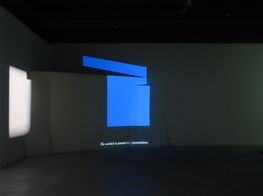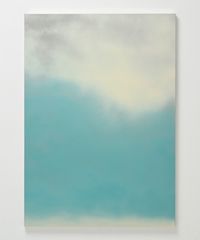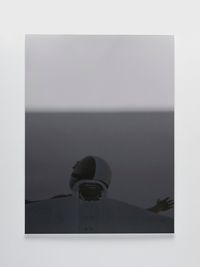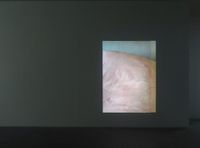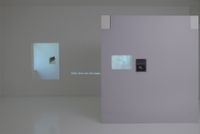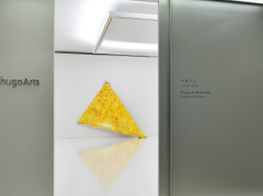Lee Kit and Yung Ma in Conversation
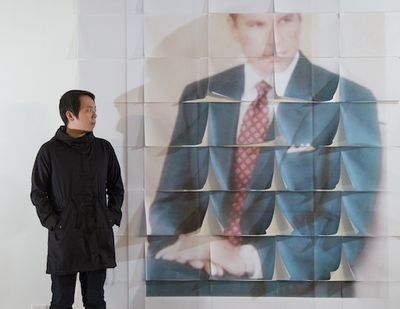
The Lee Kit exhibition, You., shown recently the Cattle Depot Artist Village in Hong Kong, was an expanded adaptation of his solo presentation for Hong Kong at the 55th Venice Biennale. The Venice presentation, entitled You (you)., received international critical acclaim and Lee was touted by the Wall Street Journal as 'one of the five artists to watch' at the Biennale.
The Hong Kong iteration, which was co-curated by Lars Nittve and Yung Ma as part of the Mobile M+ series, combined works from Venice with a number of new commissions including sound, video and ready-made objects. The exhibition reflected on the construction of memory, time, and place; and represented a continuation of Lee's investigation into the ambiguous territory between the private and public, political and social, collective and personal, and domestic and non-domestic.
While the exhibition in Hong Kong was presented as a follow up to the Venice Biennale, it was not merely a re-iteration of that exhibition. The Hong Kong show spoke more to the particular context of Hong Kong and the physicality of the Artist Village space. Lee also explored volume and scale in a way unprecedented in previous exhibitions, and the presentation of emotion — particularly in the form of anger or frustration was more pronounced.
The exhibition was, as the accompanying press release stated, an expansion of the Venice presentation, but it arguably also heralded a pivotal moment in the career of Lee. At the site of the exhibition, Anna Dickie spoke with artist Lee Kit and co-curator, Yung Ma, about the artist's earliest work, the Cattle Depot exhibition, how it differed from its Venice counterpart, and to what extent it marks a transition in his practice.
Lee Kit's current exhibition, How are things on the West Coast, is currently showing in New York at Lombard Freid, and can be regarded as a further continuation, he says, of the Venice exhibition, and its reprisal in Hong Kong.
So I think an audience who approaches Lee Kit's work has to really experience the work to activate a work, by being part of it.
You are best known for your hand-painted cloth works, such as Sunday afternoon: Picnic with friends and hand-painted cloth at Yung Shu O, Sai Kung (2003). You began to paint cloth while a student in Hong Kong in 2001. Tell me about this?
When I was a student and when I started hand painting the cloth, it was all about painting. I wanted to paint, but I didn't want to do the sketches because I loved painting and I wanted to paint continually — use painting like a diary. So I began making hand painted works daily on cloth.
Using textiles you found in Hong Kong?
Yes, I found the textiles at Sham Shui Po. I would go searching and be drawn to particular materials.
The cloth works you were making had a very muted palette. Can you tell me about the process of making the work, because it wasn't just a matter of painting cloth.
I tried ink and also paint that was especially made for dying fabric — but the quality was too good. I didn't want perfect quality. I used a washing process. I washed and re-washed the fabric, so the colour began to fade. I wanted the fabric to look old, but not be old. I wanted it to have a texture that was nostalgic. When you use acrylic, the paint on the fabric is hard. You need to wash it often for it to be soft. I liked the process involved to get the effect I wanted.
You began using the hand-painted cloth in your daily activities, for personal use and collective use, for example as a picnic blanket or for washing windows. There is a common misconception that the events in which the cloths were used formed part of a performance piece. But you have previously said it was simply a by-product of the process of making the work?
Yes, using the cloth, for example for a picnic, was just a coincidence. It came up when Hong Kong was in the midst of SARS, and the city was empty — visually the city was deserted. And very simply, my girlfriend at the time asked me if we should go on a picnic together? And I said of course — we couldn't do anything else at the time. I wasn't planning to make an artwork. We simply used the cloth for a picnic.
After the picnic, I became obsessed with the process of making the work. I found I had to stay in my studio painting, washing and seeing the effects. It became a very technical process. I became very obsessed with this process of painting and washing. I stopped seeing my old friends very often. My life became very different.
Lee is known for exploring intimate scale — and I think that is very much related to being a Hong Kong artist and the issues with space and the sacredness of space because it is so limited.
Have you found a balance?
I slowed down the production of my cloth works. I felt I was selling my life. The work has to be used naturally in my life — not rushed for an exhibition.
[Yung Ma, co-curator of 'You.' joins the conversation]
Now jumping from your earliest works to your current exhibition in Hong Kong, You., this exhibition is a continuation of your Venice Biennale exhibition. How would you define the major differences between what was presented in Venice and what is presented in Hong Kong?
YM: We didn't want to do a show in Venice that was about the "best". We had the idea that we would just do a show, and do it well. From the curators' point of view, with Venice — we just wanted to help Lee do a show that he wanted to do.
LK: In Venice we also didn't want to do a show about Hong Kong, or related to the issues of Hong Kong. We didn't feel people would care about those issues or relate to them within the context of the Venice Biennale. Local politics didn't seem relevant.
YM: It would be too hard for people to understand it.
LK: And I didn't want to take advantage of Hong Kong issues. These are serious issues.
YM: However, this show here in Hong Kong very much relates to Hong Kong.
LK: Yes, emotionally this show is relevant to Hong Kong.
YM: This show is representative of the emotions that Hong Kong evokes for Lee.
In the video about this exhibition, Lars Nittve talks about the 'anger' of this show — an anger that wasn't so present in the Venice iteration?
YM: Yes, anger is very relevant to this exhibition. There is a sense of frustration that this show is trying to express. It is mixed with a number of different emotions. It is more complex than just anger.
LK: One of the processes we used in thinking about this exhibition was to analyse what exists within the context of "anger" — frustration, for example.
Certainly what has become clearer in my work is the emotion.
The exhibition includes a wooden platform into which numerous gouges have been made. I am reminded of your work Scratching the table surface (2006-2010) — a work in which you documented yourself scratching a hole into a table surface for over four years. Do the gouges in this exhibition relate to that early work, and to the concept of anger?
LK: That work and the table as a form of expression were very much about a quiet expression of anger. But here it is less quiet.
While you have explored anger and frustration in the context of Hong Kong in this exhibition, I understand you did not want this to be a political exhibition?
YM: No. We didn't want it to be. We wanted to talk about the social and the political, but for it not to be a political show. We both felt it would be pointless to do so. This show is about the emotions that needed to be expressed.
In the exhibition there appears a blown up image of a man in a suit. The image is created from separate pieces of paper that have been placed together to create the man. Can we discuss this figure?
LK: I was obsessed with that image. This image has appeared in various projects. I am still obsessed with this image — this man who appears so smug, but foolish, at the same time.
YM: Well my interpretation of that man is that he is smug, arrogant and there is something quite perfect about him, which ultimately is what makes him look foolish. He is very much representative of a symbol of the establishment — of power.
LK: I didn't want to put anything obvious. I wanted an image that was anonymous, but that represented something.
Your use of separate sheets of paper to build the perfect image simultaneously segments and disrupts it.
YM: Yes, there is a disruption of the image. This disruption is something you see throughout the show. Take the video work, for example — they are either blurred, or otherwise made difficult to view - for example the lighting might be such that you cannot see the image properly.
LK: I also want to play with the texture of video when I make these works. I don't really view these works as a "video work" — for me they are part of a component of a painting.
It is the first time I have used scale like this. I was open to having a dialogue...
I want to talk to you about painting. Ultimately you define yourself as a "painter".
LK: Yes, I began as a painter, and many people started to talk about my work in the context of painting, including the team at M+, and I started to believe in myself again as a painter.
I noticed, looking at images of your exhibitions, that light often falls upon the objects in a manner that is reminiscent of Vermeer. I then read he is an influence.
LK: Vermeer is always in my mind. He is my favorite artist — actually the only one. I would say my work is always related to his work. Vermeer has influenced my use of light in this exhibition. Also I am attracted to the intimacy of his works — something that is reflected in my own work. There is also another thing about Vermeer — his paintings are not just portraits, they deal with wider political issues. So for example, there might be a map in the painting, which speaks to a particular social or political issue of that time. The socio-political concerns of his work are often very hidden, but they are always relevant.
Certainly with my work, I am often dealing with light, composition and subtly dealing with social and political issues — so to that extent I think Vermeer always influences me.
YM: The relationship with painting also relates to process. For example in Venice, one of the first things we wanted to do with the space was to renovate it for him. So for example, the laying of carpet at Venice was one of the first things we did — it was a sort of 'priming of the canvas'. It was about giving the artist a 'foundation' from which to work from. With Hong Kong, we spoke to Sara Wong (the designer), before we knew what Lee Kit was going to do with the show. So the platform and the walls that are installed in this show all came before the work. It was a priming of the space again.
Sara Wong has also introduced something else that I felt is new to your practice, a sense of scale and volume?
LK: Yes, this exploration of scale and volume is something that is new in my work. It is the first time I have used scale like this. I was open to having a dialogue — working in collaboration with both the curators and with Sara Wong to create this.
To what extent does this exhibition herald a type of 'transition' in your work?
YM: I think as a curator this was so important. I have known Lee Kit for a very long time. For me it is always interesting to see the turning points in an artist's practice. For instance his show at Para/Site in 2007 was a very important moment for me, and then what he did at Basel in the Statements section as well. I again saw the emergence of a new kind of transition in Venice, which is now more evident and defined in the Hong Kong exhibition.
LK: There has been a transitional period for me. For one and half years I have lived somewhere else, but actually I have spent more time in Hong Kong. I was 35 and at a stage where I started to review what has happened. When I start to look back — it becomes clearer and clearer. Certainly what has become clearer in my work is the emotion.
YM: In Venice — the exhibition — it looked like a Lee Kit show, but there were subtle details that heralded a change in his work. The shelving with the towels strewn on top — this was new. Not the use of towels — usually they are neatly folded on top of one another — but in Venice these towels were strewn.
The work has to be used naturally in my life — not rushed for an exhibition.
Does it herald a type of letting go, the more expressive painter emerging?
YM: Yes, Lee Kit kept on talking about "letting go" and that was what was important for me. With this show — the space is obviously much bigger and I was very interested to see Lee explore scale in his work. Lee is known for exploring intimate scale — and I think that is very much related to being a Hong Kong artist and the issues with space and the sacredness of space because it is so limited. Having this opportunity to play with a bigger space was an opportunity to push something he had not been able to before.
Take for example the video work involving the hand flicking the table — when it was shown in Venice, it was on two small monitors. Here we projected that video and the scale of it made it something very different.
LK: The video now works more like a moving backdrop.
YM: But, it also acts as a painting in a way. When it was small you couldn't see the texture of it. Now with the scale, it has been transformed. You can see the texture.
And the use of sound in this exhibition?
YM: Yes, of course sound has been important to Lee Kit's practice, but now it is being emphasised. Everything is still subtle and quiet, but the sound is prominent.
And what is the next project?
LK: I am actually looking forward to my next show at Lombard Freid, in New York. They have a large window, and I am fascinated by how to use that window. I also have a show in Manchester. I have been to Manchester twice. Its a show about Asian art, and I am thinking about what I can do for this because I don't like this notion of "Asian" art. The key words I am thinking about are "nothing happened". I don't just want to make a bland comment. I don't just want to follow curatorial direction.
YM: Well the thing is that Lee doesn't like to spoon feed the audience. So I think an audience who approaches Lee Kit's work has to really experience the work to activate a work, by being part of it, by thinking about the work. You need to bring your own imagination into this space. ― [O]

